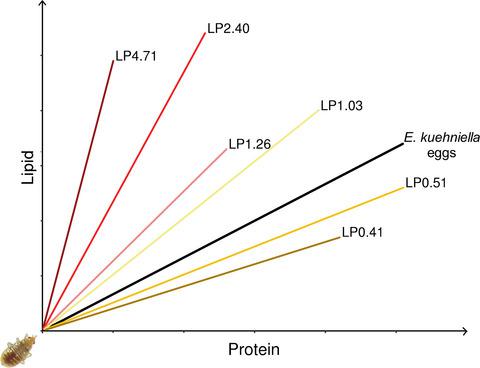当前位置:
X-MOL 学术
›
Entomol. Exp. Appl.
›
论文详情
Our official English website, www.x-mol.net, welcomes your feedback! (Note: you will need to create a separate account there.)
Fitness consequences of artificial diets with different macronutrient composition for the predatory bug Orius majusculus
Entomologia Experimentalis et Applicata ( IF 1.9 ) Pub Date : 2020-03-15 , DOI: 10.1111/eea.12881 Marta Montoro 1 , Patrick De Clercq 2 , Johannes Overgaard 3 , Lene Sigsgaard 1
Entomologia Experimentalis et Applicata ( IF 1.9 ) Pub Date : 2020-03-15 , DOI: 10.1111/eea.12881 Marta Montoro 1 , Patrick De Clercq 2 , Johannes Overgaard 3 , Lene Sigsgaard 1
Affiliation

|
The commercial production of Orius spp. (Hemiptera: Anthocoridae), including Orius majusculus (Reuter), relies on the use of eggs of Ephestia kuehniella (Zeller) (Lepidoptera: Pyralidae) as rearing diet. However, E. kuehniella eggs have become an expensive fodder thus increasing the price of these key biological control agents. The use of artificial diets potentially decreases the production costs. In this regard, establishing a link between dietary composition and fitness could advance the development of an optimum alternative artificial diet for these predatory insects. The aim of the current study was to test the effect of six artificial diets with different macronutrient composition on the development and reproductive fitness of O. majusculus when compared with the effect of E. kuehniella eggs. In general, nymphal survival was not affected by diet, whereas development was slightly delayed on artificial diets. However, female body mass and fecundity were significantly lower on all of the artificial diets compared with the E. kuehniella eggs diet, suggesting that artificial diets were of inferior quality. Within artificial diets, females fed the viable diet with highest content in lipid laid more eggs than those raised on the most protein‐rich diets. We found there was some variation in carcass composition between the O. majusculus fed the various diets, but these variations did not match the differences found in the fitness parameters measured.
中文翻译:

具有不同常量营养素成分的人工饮食对掠食性昆虫 Orius majusculus 的健康影响
Orius spp 的商业生产。(半翅目:Anthocoridae),包括 Orius majusculus (Reuter),依靠使用 Ephestia kuehniella (Zeller)(鳞翅目:Pyralidae)的卵作为饲养饮食。然而,E. kuehniella 卵已成为一种昂贵的饲料,从而增加了这些关键生物防治剂的价格。使用人工饲料可能会降低生产成本。在这方面,建立饮食成分和健康之间的联系可以促进为这些捕食性昆虫开发最佳替代人工饮食。本研究的目的是与 E. kuehniella 鸡蛋的影响相比,测试具有不同常量营养素组成的六种人工饮食对 O. majusculus 发育和生殖健康的影响。一般来说,若虫的存活不受饮食的影响,而人工饮食的发育则略有延迟。然而,与 E. kuehniella 鸡蛋饮食相比,所有人工饮食的雌性体重和繁殖力都显着降低,这表明人工饮食的质量较差。在人工饮食中,雌性喂养脂质含量最高的可行饮食比那些用蛋白质含量最高的饮食喂养的雌性产卵更多。我们发现喂食不同饮食的大鲟之间的胴体成分存在一些差异,但这些差异与测量的健康参数中发现的差异不匹配。表明人工饮食质量低劣。在人工饮食中,雌性喂养脂质含量最高的可行饮食比那些用蛋白质含量最高的饮食喂养的雌性产卵更多。我们发现喂食不同饮食的大鲟之间的胴体成分存在一些差异,但这些差异与测量的健康参数中发现的差异不匹配。表明人工饮食质量低劣。在人工饮食中,雌性喂养脂质含量最高的可行饮食比那些用蛋白质含量最高的饮食喂养的雌性产卵更多。我们发现喂食不同饮食的大鲟之间的胴体成分存在一些差异,但这些差异与测量的健康参数中发现的差异不匹配。
更新日期:2020-03-15
中文翻译:

具有不同常量营养素成分的人工饮食对掠食性昆虫 Orius majusculus 的健康影响
Orius spp 的商业生产。(半翅目:Anthocoridae),包括 Orius majusculus (Reuter),依靠使用 Ephestia kuehniella (Zeller)(鳞翅目:Pyralidae)的卵作为饲养饮食。然而,E. kuehniella 卵已成为一种昂贵的饲料,从而增加了这些关键生物防治剂的价格。使用人工饲料可能会降低生产成本。在这方面,建立饮食成分和健康之间的联系可以促进为这些捕食性昆虫开发最佳替代人工饮食。本研究的目的是与 E. kuehniella 鸡蛋的影响相比,测试具有不同常量营养素组成的六种人工饮食对 O. majusculus 发育和生殖健康的影响。一般来说,若虫的存活不受饮食的影响,而人工饮食的发育则略有延迟。然而,与 E. kuehniella 鸡蛋饮食相比,所有人工饮食的雌性体重和繁殖力都显着降低,这表明人工饮食的质量较差。在人工饮食中,雌性喂养脂质含量最高的可行饮食比那些用蛋白质含量最高的饮食喂养的雌性产卵更多。我们发现喂食不同饮食的大鲟之间的胴体成分存在一些差异,但这些差异与测量的健康参数中发现的差异不匹配。表明人工饮食质量低劣。在人工饮食中,雌性喂养脂质含量最高的可行饮食比那些用蛋白质含量最高的饮食喂养的雌性产卵更多。我们发现喂食不同饮食的大鲟之间的胴体成分存在一些差异,但这些差异与测量的健康参数中发现的差异不匹配。表明人工饮食质量低劣。在人工饮食中,雌性喂养脂质含量最高的可行饮食比那些用蛋白质含量最高的饮食喂养的雌性产卵更多。我们发现喂食不同饮食的大鲟之间的胴体成分存在一些差异,但这些差异与测量的健康参数中发现的差异不匹配。



























 京公网安备 11010802027423号
京公网安备 11010802027423号